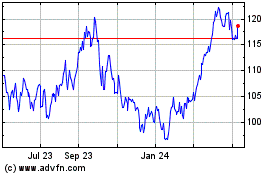By Amrith Ramkumar
Growth in oil supply is expected to accelerate next year as
global production increases, keeping crude mired in a bear market
and possibly lowering fuel prices for consumers.
At the same time, anxiety about trade tensions crimping global
growth and weakening demand has bolstered concern about a supply
glut in recent months, investors say.
The U.S. benchmark for crude fell 7.9% to $53.95 a barrel
Thursday, logging its largest one-day percentage drop since
February 2015, after President Trump said on Twitter that tariffs
of 10% would be applied to an additional $300 billion of Chinese
goods and products starting Sept. 1.
Before Mr. Trump's tweet, oil prices were down as the dollar
strengthened after the Federal Reserve refrained Wednesday from
explicitly confirming more stimulus.
The U.S. is forecast to continue driving much of the surge in
output, and increases by smaller producers such as Brazil and
Norway are expected to contribute to excess supply, according to
investors. Citigroup and JPMorgan Chase analysts currently project
supply will grow roughly one million barrels a day more than demand
in 2020, resulting in a surplus each quarter of next year.
The expected oversupply is the latest threat to the Organization
of the Petroleum Exporting Countries and other producers, many of
which are curbing output to try to balance the market.
Investors will be monitoring quarterly results from Exxon Mobil
Corp. and Chevron Corp. on Friday after most of the large energy
companies reported underwhelming figures for the first three months
of the year.
Royal Dutch Shell PLC became Thursday the latest major energy
company to report a drop in second-quarter profit from a year
earlier.
Plentiful supply has been a boon for U.S. consumers, who are on
average paying less for gasoline at the pump this summer than they
were a year ago and continue to drive economic growth even as
business investment slows. Transportation companies including Union
Pacific Corp. have cited lower fuel costs as a positive for
second-quarter profits, though there is still concern about
economic uncertainty and demand.
Many investors have long expected a surge in U.S. shale
production to continue as new pipelines from the prolific Permian
Basin of Texas and New Mexico ease bottlenecks in the region. Yet
analysts said the addition of barrels from ancillary producers
threatens to make the expected surpluses bigger, particularly as
concern about a slowing world economy triggers fears about
crumbling demand.
Analysts estimate output from offshore projects in Brazil, a
Norwegian oil field in the North Sea and easing production
curtailments in Canada could produce several hundred thousand
barrels a day of crude next year. That figure is still relatively
small, but growth from those projects is bolstering bets output
will exceed consumption.
"Those are very relevant in tipping the scales," said Rebecca
Babin, a senior energy trader at CIBC Private Wealth Management.
"It's very hard for people to look at the 2020 supply-demand
imbalances and want to get long," referring to bullish
positions.
The projections for oversupply explain in part why oil prices
have barely moved in response to recent attacks in and near the
Strait of Hormuz, a critical shipping area near the Persian
Gulf.
Before Thursday's slide, U.S. crude prices had generally stayed
in a range of $55 to $60 a barrel during the past six weeks,
remaining well below their 2019 peak above $66. Oil would need to
close at or above $61.37 to exit from its current bear market,
which began in early June when crude closed 20% below its April
high.
Prices are up in 2019, though they are still down about 20% in
the past year. The moves have encouraged hedge funds and other
speculative investors to boost bets prices will fall.
The ratio of bullish bets to bearish wagers by the group on U.S.
crude has fallen to just over 3, down from last year's peak of 26
in July 2018. The most recent figures showed speculators increased
bearish bets by nearly 50% from a week earlier.
"There's a greater appreciation now that we're not in a
supply-constrained world," said Noah Barrett, an energy research
analyst at Janus Henderson Investors.
Inventories have already been rising. Oil stockpiles in
Organization for Economic Cooperation and Development countries
rose in each of the first five months of the year, the
International Energy Agency estimates.
The group expects that the world's requirement for OPEC crude is
set to fall next year to its lowest level in 16 1/2 years as supply
outside the cartel rises.
Prices haven't seen a boost even with supply disruptions at
their highest in three decades.
That means any shifts in sanctions policies affecting Iran and
Venezuela or other political developments could add to bearish
momentum.
"Some of the constraints on capacity could come off if
geopolitical events change, on top of the potential growth," said
Darwei Kung, a portfolio manager of the $2.8 billion DWS Enhanced
Commodity Strategy Fund. "That's one of the reasons we're a little
bit concerned about what the increase might mean to the global
balance."
Still, some analysts hope that OPEC will continue curbing output
and that demand will exceed low expectations, supporting crude and
beaten-down shares of producers. Investors are also demanding
discipline from U.S. oil companies, many of which are limiting
production activity.
With the S&P 500 energy sector down about 20% in the past
year, some say companies with lower costs and higher shareholder
returns look attractive, even if oil stays in its current
range.
"The way to play it is to be cautious and select the quality
names," said David Yepez, a portfolio manager at Exencial Wealth
Advisors, which has been increasing positions in Exxon and Pioneer
Natural Resources Co. recently.
Write to Amrith Ramkumar at amrith.ramkumar@wsj.com
(END) Dow Jones Newswires
August 01, 2019 21:47 ET (01:47 GMT)
Copyright (c) 2019 Dow Jones & Company, Inc.
Exxon Mobil (NYSE:XOM)
Historical Stock Chart
From Mar 2024 to Apr 2024

Exxon Mobil (NYSE:XOM)
Historical Stock Chart
From Apr 2023 to Apr 2024
